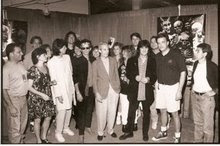
November 2009
The Pine Ridge Reservation
In many ways South Dakota’s Pine Ridge Reservation, home of the Lakota Sioux Tribe, is a saturated “fly trap” of well intended do-gooders. While researching life style statistics for this report I found volumes of websites, blogs, articles and postings by groups and individuals working to alleviate the extreme poverty and harsh living conditions of the 18,600+ people on the Pine Ridge.
While I have been unable to verify all of these figures (see attached sheet of verified figures), the Pine Ridge Reservation Is among, if not thee, poorest counties in the United States.
This area is afflicted with some of society’s most devastating problems including; poverty, alcoholism, diabetes, teen suicide and violence.
Here are some facts, many of which contradict each other, I have found on the internet;
1.)
According to ‘Red Cloud Indian School’ (Pine Ridge Indian Reservation Demographics, 2009);
• 80% of residents are unemployed (versus 10% of the rest of the country)
• 49% of the residents live below the Federal poverty level (61% under the age of 18),
• Per Capita income in Shannon County is $6,286,
• The Infant Mortality rate is 5X higher than the national average,
• Native American amputation rates due to diabetes is 3 to 4X higher than the national average
• Death rate due to diabetes is 3X higher than the national average
• Other than Haiti, Life Expectancy on the Pine Ridge is the lowest in the Western Hemisphere;
-Men 48 years,
-Women, 52 years
2.)
According to the New York Times (Kilborn, 1992);
• The Pine Ridge covers 2 million acres (Larger than Connecticut),
• 63.1% of all residents live in poverty in 1989 (national average 14.2% in 1991)
• The interview was with Father Joseph Daniel Sheehan
3.)
According to City-Data.com (Pine Ridge, South Dakota (the city), 2007);
Pine Ridge South Dakota % Difference
Median Household income $24,346 $43,424 56.07%
Median Age 19.7 35.6 55.34%
Est. per Capita Income $7,373 $22,252 33.13%
Est. median home value $27,379 $118,700 23.07%
Average household size 4.4 2.5 (people) 176.00%
Percentage family hholds 86.2% 67.0% 128.66%
Residents with income below the poverty level 2007
61.0% 13.2% 462.12%
Residents with income below 50% of the poverty level 2007
25.9% 5.8% 446.55%
For the population over the age of 25;
- High School or higher 62.1%
- Bachelors degree or higher 4.3%
- Grad. Or Prof. degree 1.2%
- Unemployed 35.5%
4.)
According to ‘Native American Times’ (Schwartz, 2006);
• 58.7% of Grandparents on the Reservation are responsible for raising their own grandchildren,
• The median income varies between $2,600 and $3,500 per year,
• 97% of the population lives below the Federal poverty line,
• The unemployment rate “is said to be approximately 83-85% and can be higher during winter…”
• Teenage suicide rates on Pine Ridge Reservation are 150% higher than the U.S. national average for this age group,
• The infant mortality rate is the highest on this continent and is about 300% higher than the U.S. national average,
• The rate of diabetes on the Reservation is reported to be 800% higher than the U.S. national average,
• Reports indicate that 50% of adults on the Reservation over the age of 40 have diabetes,
• The tuberculosis rate on the Pine Ridge Reservation is approximately 800% higher than the U.S. national average,
• Cervical cancer is 500% higher than the U.S. national average,
• “It is reported that at least 60% of the homes on the Pine Ridge Reservation are infested with Black Mold Stachybotrys.”
• The school drop-out rate is over 70%
• Teacher turnover (rate) is 800% that of the U.S. national average,
• “There is an estimated average of 17 people living in each family home( a home which may have two to three rooms).”
• 39% of homes on the Reservation have no electricity,
• There are no public libraries except one at the Oglala Lakota College (in an area the size of Connecticut),
• Alcoholism affects eight out of ten families on the Reservation,
• The death rate from alcohol-related problems on the Reservation is 300% higher than the remaining U.S. population,
5.)
According to the United States government's Census Bureau, 2009 (www.quickfacts.census.gov)
South Shannon Reported
Nebraska U.S.A. Dakota County Pine Ridge
Education
2008 Bachelors Degrees 23.70% 24.40% 21.50% 12.10% 4.30%
2008 High School Diploma 86.60% 80.40% 84.60% 70.00% 62.10%
2008 Population Change 4.20% 8.00% 6.50% 9.40%
2000 Home Ownership 67.40% 66.30% 68.20% 48.60%
2000 Persons per Home 2.49 2.59 2.50 4.36
2008 Below Poverty 11.1 13.0 13.2 47.4 (below)
2008 Med. Hhold Income 47072 50740 43507 25964
2000 Med. Home Value 88000 119600 79600 25900 27397
1999 Per Capital Income 19613 21587 17652 6286 7373
2008 Retail Sls per Capita 11729 10615 12626 2347
2008 Building Permits 6346 905359 3884 0
2008 Population 1783432 304mill 804194 13637 28787
1990 Native Population 12410 1937391 50575 14295
1990 % Native Population 0.8% 7.3% 0.8% 92.2%
2008 Federal Dollars 13.9m 2.536b 8.7mil 139,986
2008 Fed Dollars per Cap. $7.84 $8.34 $10.92 $10.27
1995 Population % Veterns 11.0% 10.5%
Poverty Reports for Pine Ridge residents U.S. Census Report 2000
46.4% of households on Pine Ridge are in poverty.49% 1990)
39.4% of Sioux families lived in poverty; 44.4% of individuals
60.5% of households have no father figure in the home.
47.5% of the Pine Ridge above the age of 18 live in poverty.
Native Population U.S.A. taken in 1995
Native Population Shannon County taken in 2000 Approximate
Individual
Indian Health Services Budget 2007 (HIS) $4.2 Billion $13.92
Bureau Indian Affairs 2010 Budget 2007 (BIA) $22. Billion $73.07
"Reported" Annual Pine Ridge income from Casino per individual $0.15
Works CitedKilborn, P. T. (1992, September 20). Life at the Bottom - America's Poorest County / A Special Report; Sad Discinction for the Sioux: Homeland Is No.1 in Poverty. Retrieved 2009 October, from The New York Times : www.nytimes.com/1992/09/20/us/life-bottom-america-s-poorest-county-special-report
Pine Ridge Indian Reservation Demographics. (2009, July ). Retrieved 2009 October, from Red Cloud School: www.redcloudschool.org
Pine Ridge, South Dakota (the city). (2007, July). Retrieved August 28, 2009, from City Data.com: www.city-data.com/city/Pine-Ridge-South-Dakota.html
Schwartz, S. M. (2006, November 3). Life, conditions, and hopes on the Pine Ridge Oglala Lakota (Sioux) Reservation of SD. Retrieved 2009 23, October , from Native American Times: http://proquest.umi.com/pqdlink?vinst=PROD&fmt=3&startpage=-1&ver=1&vname=PQ...
United States Census Bureau. (2009). Retrieved September 2009, from quickfacts.census.gov: www.quickfacts.census.gov
This report compiled by Prof. Rick Galusha
Galusha can be contacted at rick.galusha@gmail.com
Listen to the Pacific Street Blues & Americana radio program on Sunday, December 6th for our 3rd annual 'Toys for the Pine Ridge' phone drive. Hear the show live, online at www.897theriver.com 9 a.m. - Noon CST. Join us as Lash LaRue's citywide effort to bring a smile and a ray of sunshine to a Native child's face. YOU really can make a difference!
















